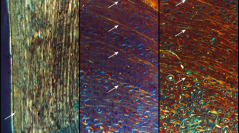

 Comptes Rendus Palevol
15 (1-2) - Pages 267-277
Comptes Rendus Palevol
15 (1-2) - Pages 267-277Histological approaches to extant mammalian life histories (LHs) provide the basis for reconstructing LHs of fossil mammals. They are of special interest in lineages such as perissodactyls that played a key role in fossil ecosystems. We studied an ontogenetic series of Equus hemionus (Asiatic wild ass), the most appropriate extant representative of fossil horses. We analyzed growth marks in femora of 10 specimens of different ontogenetic stages and habitats. Bone tissue types and vascular canal orientation vary both during ontogeny and within cross-sections. Skeletochronology generally fits previous age estimates from dental eruption patterns. Our wild adult female attained skeletal maturity at the age of four, the wild male at 5 years. Our results do not only contribute to our knowledge of Asiatic wild ass but they also show that bone histology is a valid tool in reconstructing LH evolution in the horse lineage.
Equus hemionus, Life history, Bone histology, Skeletochronology, Longevity, Sexual maturity